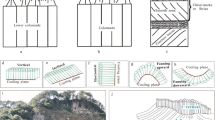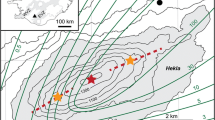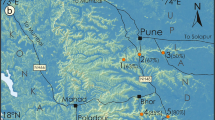Abstract
Upper crustal prismatic joints and vesicle cylinders, common in pāhoehoe lava flows, form early and late, respectively, and are therefore independent features. However, small-scale compound pāhoehoe lava lobes on Elephanta Island (western Deccan Traps, India), which resemble S-type (spongy) pāhoehoe in some aspects, contain vesicle cylinders which apparently controlled the locations of upper crustal prismatic joints. The lobes are decimeters thick, did not experience inflation after emplacement, and solidified rapidly. They have meter-scale areas that are exceptionally rich in vesicle cylinders (up to 68 cylinders in 1 m2, with a mean spacing of 12.1 cm), separated by cylinder-free areas, and pervasive upper crustal prismatic jointing with T, curved T, and quadruple joint intersections. A majority (≥76.5%) of the cylinders are located exactly on joints or at joint intersections, and were not simply captured by downward growing joints, as the cylinders show no deflection in vertical section. We suggest that large numbers of cylinders originated in a layer of bubble-rich residual liquid at the top of a basal diktytaxitic crystal mush zone which was formed very early (probably within the first few minutes of the emplacement history). The locations where the rising cylinders breached the crust provided weak points or mechanical flaws towards which any existing joints (formed by thermal contraction) propagated. New joints may also have propagated outwards from the cylinders and linked up laterally. Some cylinders breached the crust between the joints, and thus formed a little later than most others. The Elephanta Island example reveals that, whereas thermal contraction is undoubtedly valid as a standard mechanism for forming upper crustal prismatic joints, abundant mechanical flaws (such as large concentrations of early-formed, crust-breaching vesicle cylinders) can also control the joint formation process.










Similar content being viewed by others
References
Anderson AT, Swihart GH, Artioli G, Geiger CA (1984) Segregation vesicles, gas filter-pressing, and igneous differentiation. J Geol 92:55–72
Aydin A, DeGraff JM (1988) Evolution of polygonal fracture patterns in lava flows. Science 239:471–476
Baksi AR (2014) The Deccan Trap–Cretaceous-Palaeogene boundary connection: new 40Ar/39Ar ages and critical assessment of existing argon data pertinent to this hypothesis, in Sheth HC, Vanderkluysen L (eds) flood basalts of Asia. J Asian Earth Sci 84:9–23
Barreto CJS, Lima EF, Scherer CM, Rossetti LMM (2014) Lithofacies analysis of basic lava flows of the Paraná igneous province in the south hinge of Torres syncline, southern Brazil. J. Volcanol Geotherm Res 285:81–99
Barreto CJS, Lima EF, Goldberg K (2017) Primary vesicles, vesicle-rich segregation structures and recognition of primary and secondary porosities in lava flows from the Paraná igneous province, southern Brazil. Bull Volcanol 79:31. doi:10.1007/s00445-017-1116-x
Beane JE, Turner CA, Hooper PR, Subbarao KV, Walsh JN (1986) Stratigraphy, composition and form of the Deccan basalts, western Ghats, India. Bull Volcanol 48:61–83
Bondre NR, Duraiswami RA, Dole G (2004) Morphology and emplacement of flows from the Deccan volcanic province, India. Bull Volcanol 66:29–45
Boudreau A (2016) Bubble migration in a compacting crystal-liquid mush. Contrib Mineral Petrol 171:32. doi:10.1007/s00410-016-1237-9
Brown RJ, Blake S, Bondre NR, Phadnis VM, Self S (2011) ‘A’ā lava flows in the Deccan volcanic province, India, and their significance for the nature of continental flood basalt eruptions. Bull Volcanol 73:737–752
Budkewitsch P, Robin P-Y (1994) Modelling the evolution of columnar joints. J Volcanol Geotherm Res 59:219–239
Carman MF Jr (1994) Mechanisms of differentiation in shallow mafic alkaline intrusions, as illustrated in the Big Bend area, western Texas. J Volcanol Geotherm Res 61:1–44
Caroff M, Maury RC, Cotten J, Clément J-P (2000) Segregation structures in vapour-differentiated basaltic flows. Bull Volcanol 62:171–187
Cashman K, Mangan M, Newman S (1994) Surface degassing and modifications to vesicle size distributions in active basalt flows. J Volcanol Geotherm Res 61:45–68
Costa A, Blake S, Self S (2006) Segregation processes in vesiculating crystallizing magmas. J Volcanol Geotherm Res 153:287–300
DeGraff JM, Aydin A (1987) Surface morphology of columnar joints and its significance to mechanics and direction of joint growth. Geol Soc Am Bull 99:605–617
Devey CW, Lightfoot PC (1986) Volcanological and tectonic control of stratigraphy and structure in the western Deccan Traps. Bull Volcanol 48:195–207
Dickinson WR, Vigrass LW (1965) Geology of the Suplee-Izee area, Crook, Grant, and Harney Counties. Oregon Dept Geol Min Res Bull 58:110 p
Duraiswami RA, Bondre NR, Managave S (2008) Morphology of rubbly pāhoehoe (simple) flows from the Deccan volcanic province: implications for style of emplacement. J Volcanol Geotherm Res 177:822–836
Duraiswami RA, Gadpallu P, Shaikh TN, Cardin N (2014) Pāhoehoe-‘a’ā transitions in the lava flow fields of the western Deccan Traps, India—implications for emplacement dynamics, flood basalt architecture and volcanic stratigraphy, in Sheth HC, Vanderkluysen L (eds) flood basalts of Asia. J Asian Earth Sci 84:146–166
Forbes AES, Blake S, Tuffen H (2014) Entablature: fracture types and mechanisms. Bull Volcanol 76:820, doi: DOI 10.1007/s00445-014-0820-z
Fowler AC, Rust AC, Vynnycky M (2015) The formation of vesicular cylinders in pāhoehoe lava flows. Geophys Astrophys Fluid Dyn 109:39–61
Goff F (1996) Vesicle cylinders in vapour-differentiated basalt flows. J Volcanol Geotherm Res 71:167–185
Gregg TKP, Keszthelyi LP (2004) The emplacement of pāhoehoe toes: field observations and comparison to laboratory simulations. Bull Volcanol 66:381–391
Guilbaud M-N, Self S, Thordarson T, Blake S (2005) Morphology, surface structures, and emplacement of lavas produced by Laki, A.D. 1783–84. In: Manga M, Ventura G (eds) Kinematics and dynamics of lava flows, Geol Soc Am Spec Pap, vol 396, pp 81–102
Harris AJL, Rowland SK, Villeneuve N, Thordarson T (2017) Pāhoehoe, ‘a‘ā, and block lava: an illustrated history of the nomenclature. Bull Volcanol 79:7. doi:10.1007/s00445-016-1075-7
Hartley ME, Thordarson T (2009) Melt segregations in a Columbia River basalt lava flow: a possible mechanism for the formation of highly evolved mafic magmas. Lithos 112:434–446
Helz R (1980) Crystallization history of Kilauea Iki lava lake as seen in drill core recovered in 1967–1979. Bull Volcanol 43:675–701
Hon K, Kauahikaua J, Denlinger R, McKay K (1994) Emplacement and inflation of pāhoehoe sheet flows: observations and measurements of active lava flows on Kilauea volcano, Hawaii. Geol Soc Am Bull 106:351–370
Keszthelyi L, Denlinger R (1996) The initial cooling of pāhoehoe flow lobes. Bull Volcanol 58:5–18
Keszthelyi L, Self S, Thordarson T (1999) Application of recent studies on the emplacement of basaltic lava flows to the Deccan Traps. In: Subbarao KV (ed) Deccan volcanic province. Geol Soc Ind Mem 43(1):485–520
Kulander BR, Barton CC, Dean SL (1979) Application of fractography to core and outcrop fracture investigations. US Dept Energy Paper METC/SP-79/3, 174 p
Lister JR, Kerr RC (1989) The effect of geometry on the gravitational instability of a buoyant region of viscous fluid. J Fluid Mech 202:577–594
Long PE, Wood BJ (1986) Structures, textures, and cooling histories of Columbia River basalt flows. Geol Soc Am Bull 97:1144–1155
Macdonald GA (1953) Pāhoehoe, ‘a’ā, and block lava. Am J Sci 251:169–191
Marshall PE, Widdowson M, Murphy DT (2016) The Giant lavas of Kalkarindji: rubbly pāhoehoe lava in an ancient continental flood basalt province. Palaeogeogr Palaeoclim Palaeoecol 441:22–37
Mattox TN, Heliker C, Kauahikaua J, Hon K (1993) Development of the 1990 Kalapana flow field, Kilauea volcano, Hawaii. Bull Volcanol 55:403–413
Merle R, Caroff M, Girardeau J, Cotten J, Guivel C (2005) Segregation vesicles, cylinders, and sheets in vapour-differentiated pillow lavas: examples from Tore-Madeira Rise and Chile Triple Junction. J Volcanol Geotherm Res 141:109–122
Nichols RL (1936) Flow-units in basalt. J Geol 44:617–630
Pande K, Yatheesh V, Sheth H (2017) 40Ar/39Ar dating of the Mumbai tholeiites and Panvel flexure: intense 62.5 Ma onshore-offshore Deccan magmatism during India-Laxmi Ridge-Seychelles breakup. Geophys J Int 210:1160–1170
Peck DL, Minakami T (1968) The formation of columnar joints in the upper part of Kilauean lava lakes, Hawaii. Geol Soc Am Bull 79:1151–1166
Philpotts AR, Carroll M, Hill JM (1996) Crystal-mush compaction and the origin of pegmatitic segregation sheets in a thick flood-basalt flow in the Mesozoic Hartford Basin, Connecticut. J Petrol 37:811–836
Puffer JH, Horter DL (1993) Origin of pegmatitic segregation veins within flood basalts. Geol Soc Am Bull 105:738–748
Puffer JH, Laskowich C (2012) Volcanic diapirs in the Orange Mountain flood basalt: New Jersey, USA. J Volcanol Geotherm Res 237-238:1–9
Renne PR, Sprain CJ, Richards MA, Self S, Vanderkluysen L, Pande K (2015) State shift in Deccan volcanism at the Cretaceous-Palaeogene boundary, possibly induced by impact. Science 350:76–78
Ryan MP, Sammis CG (1978) Cyclic fracture mechanisms in cooling basalt. Geol Soc Am Bull 89:1295–1308
Rice RW (1974) Fracture topography of ceramics. In: Frechette VD, LaCourse WC, Burdick VL (eds) Materials science research Vol 7: surfaces and interfaces of glass and ceramics. Plenum Press, New York, pp 439–472
Rowland SK, Walker GPL (1990) Pāhoehoe and ‘a’ā in Hawaii: volumetric flow rate controls the lava structure. Bull Volcanol 52:615–628
Samant H, Pundalik A, D’Souza J, Sheth H, Carmo Lobo K, D’Souza K, Patel V (2017) Geology of the Elephanta Island fault zone, western Indian rifted margin, and its significance for understanding the Panvel flexure. J Earth Syst Sci 126:9. doi:10.1007/s12040-016-0793-8
Sarkar PK, Mude SN (2010) Remnants of vertical and lateral migration of the entrapped volatiles and gases in the Deccan Trap basalts at Bhaja, Maval Taluka of Pune District, Maharashtra. J Geol Soc Ind 75:560–562
Sarkar PK, Upasani DV, Sikilkal NA, Moray GM (2015) Physical evidence of vesicular cylinders in pāhoehoe lava flow at Pataleshwar temple, Pune, India. J Geosci Res (Gondwana Geol Soc, Nagpur) 1:11–15
Self S, Thordarson T, Keszthelyi L (1997) Emplacement of continental flood basalt lava flows. In: Mahoney JJ, Coffin MF (eds) Large igneous provinces: continental, oceanic, and planetary flood volcanism, Am Geophys union Geophys Monogr, vol 100, pp 381–410
Self S, Keszthelyi L, Thordarson T (1998) The importance of pāhoehoe. Annu Rev Earth Planet Sci 26:81–110
Sheth HC (2006) The emplacement of pāhoehoe lavas on Kilauea and in the Deccan Traps. J Earth Syst Sci 115:615–629
Sheth H, Samant H, Patel V, D’Souza J (2017a) The volcanic geoheritage of the Elephanta Caves, Deccan Traps, western India. Geoheritage, in press, doi. doi:10.1007/s12371-016-0214-z
Sheth H, Pal I, Patel V, Samant H, D’Souza J (2017b) Breccia-cored columnar rosettes in a rubbly pāhoehoe lava flow, Elephanta Island, Deccan Traps, and a model for their origin. Geosci Front, in press, doi. doi:10.1016/j.gsf.2016.12.004
Spry A (1962) The origin of columnar jointing, particularly in basalt flows. J Austr Geol Soc 8:191–216
Swanson DA (1973) Pāhoehoe flows from the 1969-1971 Mauna Ulu eruption, Kilauea volcano, Hawaii. Geol Soc Am Bull 84:615–626
Thordarson T, Self S (1998) The Roza Member, Columbia River Basalt Group: a gigantic pāhoehoe lava flow field formed by endogenous processes? J Geophys Res 103:27411–27445
Verma SP, Torres-Alvarado IS, Sotelo-Rodriguez ZT (2002) SINCLAS: standard igneous norm and volcanic rock classification system. Comput Geosci 28:711–715
Walker GPL (1971) Compound and simple lava flows and flood basalts, in Aswathayarayana U (ed) Deccan Trap and other flood eruptions. Bull Volcanol 35:579–590
Walker GPL (1989) Spongy pāhoehoe in Hawaii: a study of vesicle-distribution patterns in basalt and their significance. Bull Volcanol 51:199–209
Walker GPL (1991) Structure, and origin by injection of lava under surface crust, of tumuli, “lava rises”, “lava-rise pits”, and “lava-inflation clefts” in Hawaii. Bull Volcanol 53:546–558
Wilmoth RA, Walker GPL (1993) P-type and S-type pāhoehoe: a study of vesicle distribution patterns in Hawaiian lava flows. J Volcanol Geotherm Res 55:129–142
Wilson SA (1997) Data compilation for USGS reference material BHVO-2. Hawaiian basalt, US Geol Surv Open File Rep
Acknowledgements
Vanit Patel was supported by a Junior Research Fellowship from the University Grants Commission (UGC), Government of India. We thank Joseph D’Souza and Arnav Samant for their valuable field assistance and Raymond Duraiswami for the discussions of some outcrop photographs during an early stage of development of our ideas. The manuscript was considerably improved by constructively critical reviews from journal referees Carla Barreto and Peter E. Marshall and Editors Richard J. Brown and Andrew Harris.
Author information
Authors and Affiliations
Corresponding author
Additional information
Editorial responsibility: R.J. Brown
Rights and permissions
About this article
Cite this article
Sheth, H., Patel, V. & Samant, H. Control of early-formed vesicle cylinders on upper crustal prismatic jointing in compound pāhoehoe lavas of Elephanta Island, western Deccan Traps, India. Bull Volcanol 79, 63 (2017). https://doi.org/10.1007/s00445-017-1147-3
Received:
Accepted:
Published:
DOI: https://doi.org/10.1007/s00445-017-1147-3




